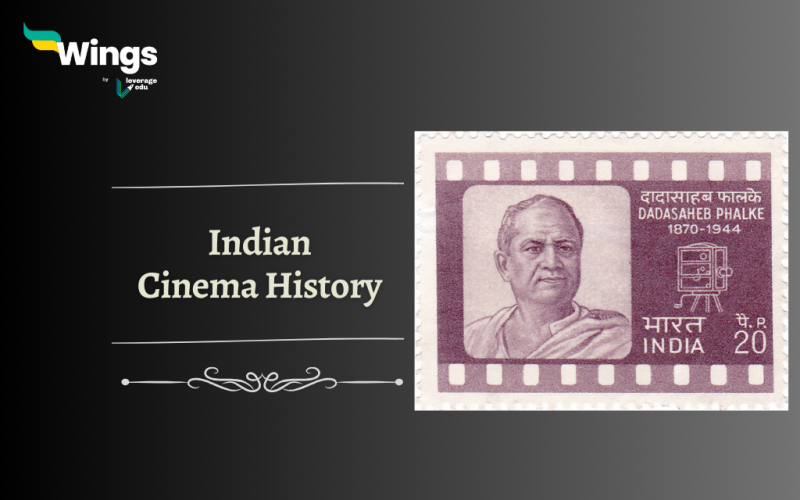From “Kitne Aadmi They”, to “Mogambo Khush Hua” to “All Is Well”, Indian cinema history comes from a long alley of drama, dialogue and discourse. According to reports – The Indian film industry is the largest film industry in the world, wherein it produces between 1,500 to 2,000 films every year in more than 20 languages. But from where did it all start? Do you want to know the history of Indian cinema, let’s take this journey down the lane to know about this glorious start in the sub-continent.
Table of Contents [show]
Timeline In Indian History
| Silent Era (1890’s – 1920’s) | |
| 1896 | Lumiere Brothers screened their cinematographe |
| 1897 | Professor Stevenson presented a film in Calcutta |
| 1898 | “The Flower of Persia”, scenes from a stage show was filmed by Hiralal Sen |
| 1899 | “The Wrestler” was shot by H. S Bhatavdekar, the first Indian to shoot. |
| 1913 | Dadasaheb Phalke’s Raja Harishchandra” was released, becoming the first Indian Film. |
| Sound Era | |
| 1931 | The first talkie film “Alam Ara” was made by Ardeshir Irani |
| 1932 | The First Marathi sound Film “ Ayodhyecha Raja” was released. |
| 1933 | “Savitri” was produced by the East India Company |
| 1935 | The First Assamese Film “ Joymoti” by Jyoti Prasad Agarwala was released. |
| 1936 | The First South Indian Film studio was built by Durga Cinetone |
| 1937 | “Tent Cinema” was introduced by Swamikannu Vincent in Madras |
| 1940 | The first Indian Film showing movie-making was “Viswa-Mohini” |
| Golden Age | |
| 1940 – 1960’s | Emergence of Parallel cinema |
| 1986 | India became the world’s Largest Film producers |
| “Bollywood” was coined for Indian Films | |
Indian Cinema Evolution
Auguste and Louis Lumiere, popularly known as the Lumiere Brothers invented the cinematographe, which was a camera and a projector device. The device was a combination was a game-changer as it allowed multiple people to view a film at the same time, unlike the peeping device called the Kinetoscope of Edison and Dickson, which only allowed one person to view at a time. The brothers visited India in 1896 and showcased six silent short films in Mumbai, which were a series of visuals and seeds for the start of motion pictures in India. The cinema was first shown at the Watson Hotel in Mumbai on July 17, 1896.
- However, for the next fifteen years, no film was made in India. But it started a Silent Era.
- N.G Chitre and R.G Torney, two filmmakers attempted to make a film called PUNDALIK, based on the story of a holy man in Maharashtra.
- India’s first Feature film was RAJA HARISHCHANDRA, directed, written and acted by Dandiraj Govindraj Phalke himself on 3rd May 1913.
- Dadasaheb Phalke became the “Father of Indian Cinema”, and even after a decade, his films are considered legendary and ahead of their time.
The Silent Era came to an end in the year 1930 with the advent of technology and sound. Thus, the Age of Sound came with transforming experiences for the Indian audience.
The Golden Era
- In 1931, Alam Ara became the first Indian Talkie film directed by Ardeshir Irani.
- The Indian Cinema peaked at its height in the 1950s and experienced its golden era when all these while films were made in Black & White, but now there was the inclusion of Colour in cinema.
- “Kisan Kanya” became the first ever coloured film of India.
- With iconic films like “Mughal-E-Azam” and “Mother India”, etc, Legendary actors such as Raj Kapoor, Dilip Kumar, and Dev Anand also rose to prominence during this period.
- Filmmakers like Guru Dutt and Bimal Roy created cinematic masterpieces that are revered to this day.
Also Read – 16 Shocking Facts About the Bollywood Industry
Global Recognition And Modern Era
It becomes impossible not to mention the era of the 1960s and 1970s of Indian Cinema. Actors turned into Super Heroes, Emotions of love and drama turned into Actions and Realism. There was the emergence of actors like Dev Anand, Raj Kapoor and Dilip Kumar, and actresses like Madhubala, etc.
- The 1990s marked a shift in Indian cinema with the emergence of alternative and experimental films.
- With the actors, several directors also made their mark with their stories – Manmohan Desai, Satyajit Ray, Meera Nair and Aparna Sen.
- Filmmakers like Satyajit Ray and Aparna Sen gained international acclaim for their thought-provoking work.
- Indian cinema began to explore diverse genres and themes, resonating with audiences worldwide.
Later joined the famous Rajesh Khanna, Dharmendra, Amitabh Bachchan, Hema Malini, Rekha, etc. Films that were liked and loved included Devdas, Sholay, Shahenshah, Umao Jaan, etc.
Beyond 1990s
- The advent of digital technology revolutionized the way films were made and distributed.
- Visual effects and CGI have allowed filmmakers to bring larger-than-life stories to the screen with unparalleled realism.
- Indian cinema now boasts state-of-the-art production values and world-class technical expertise.
New and fresh faces were widely accepted like Salman Khan, Shah Rukh Khan, Madhuri Dixit, Amir Khan, Govinda, Karisma Kapoor, Ajay Devgan, Akshay Kumar, etc. We have come to an era when now we accept OTT as the new experience of watching films and getting comfortable with the new screens.
Relevant Blogs
This blog was all about Indian Cinema history. If you want to read more articles like this, you can get Short notes on the Modern History of India here. Also, you can visit our general knowledge page on Indian History!
 One app for all your study abroad needs
One app for all your study abroad needs















 45,000+ students trusted us with their dreams. Take the first step today!
45,000+ students trusted us with their dreams. Take the first step today!
